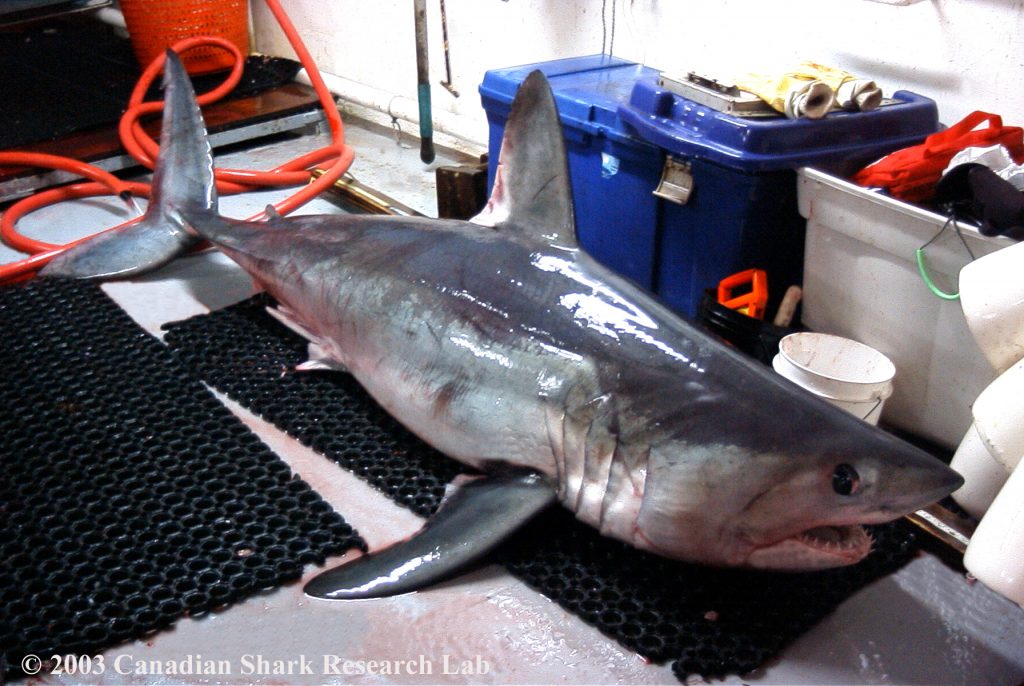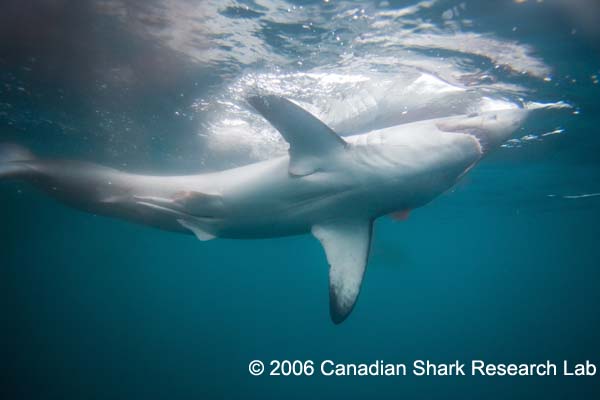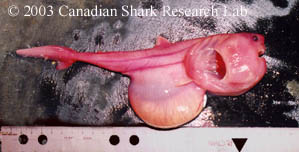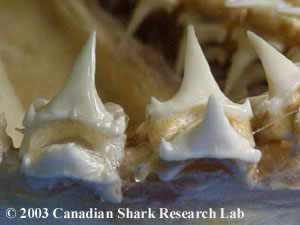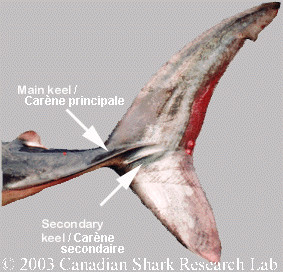Porbeagle Shark
Description
The porbeagle is a stout shark that is blue-gray on top and white underneath with a white patch on the trailing edge of the first dorsal fin. It has a heavy spindle-shaped body and a conical snout. It has a crescent shaped tail and a secondary keel that effectively cuts the water during the side to side swimming motion. This shark has relatively large dark eyes. The teeth in the moderately sized mouth are similar in both the upper and lower jaw (they are smooth-edged with lateral denticles), although young individuals may lack the lateral denticles.
Range
Porbeagles occur on both sides of the Atlantic, and in the south Pacific and Indian Oceans. In the western North Atlantic it can be found from Raleigh, Newfoundland at its northernmost range to the Gulf of St. Lawrence, the Scotian Shelf, the Bay of Fundy and the Gulf of Maine to New Jersey. It's pupping ground is further south, in the Sargasso Sea north of Cuba.
Habitat
The porbeagle shark is common in pelagic and littoral zones, and inhabits water down to a depth of 1360 meters (4,200 feet). Off eastern Canada, it is most commonly found on the continental shelf or near the shelf edge, but sometimes comes inshore. It prefers cool waters and is usually found in temperatures between 5-12 degrees Celsius. It is the second most commonly observed large shark in Atlantic waters.
Life History
Adults can attain a size of over 3 meters (10 -12 feet) but usually average between 1.5-1.8 m in length and about 135 kg. They have an average life expectancy of 30 to 40 years. Age and growth rate has been confirmed in this species, indicating that growth rings in the vertebrae accurately indicate age for at least 26 years. The porbeagle has a heat regulating mechanism that raises the body temperature 3 to 8 degrees Celsius above the surrounding water temperature. This allows the shark to be active and strong swimming in the cooler waters it inhabits. Unlike many other sharks the porbeagle must swim at all times in order to breathe. The porbeagle undertakes extensive annual migrations in the North Atlantic from Massachusetts up along the Scotian Shelf to Newfoundland. Mature females migrate south to the Sargasso Sea (between Bermuda and Cuba) to give birth to their pups.
Diet
The porbeagle feeds mainly upon pelagic fishes such as herring, lancetfish and mackerel. However they also eat cod, redfish, haddock, squid and shellfish. They do not feed upon marine mammals.
Reproduction
The porbeagle is ovoviviparous, retaining the developing young within the brood chamber before giving birth to live young. The developing sharks obtain nutrients by consuming other fertilized eggs in the oviduct (oophagy). Young are born in the late winter and spring. The females can have between 1-5 pups but generally produce 4 pups that are between 60 to 75 cm long at birth. Female porbeagles reach sexual maturity at a size of about 217 cm (age of about 13 years), while the males are mature at about 174 cm (age 8).
Interaction with People
The porbeagle shark is the target of a directed fishery in Atlantic Canada, and has been the subject of considerable research in our laboratory. The porbeagle is often seen inshore and around mouths of estuaries in Nova Scotia and New Brunswick in late summer. This shark is a fish eater and is not normally a problem for people, including swimmers.
Distinguishing Characteristics
- White patch on the trailing edge of the first dorsal fin
- Caudal fin with secondary keel
- Lateral denticles on the teeth
- Lunate tail
